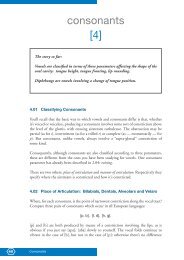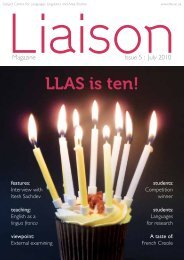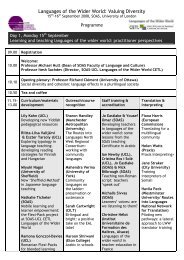PHONETICS MANUAL.indd - HumBox
PHONETICS MANUAL.indd - HumBox
PHONETICS MANUAL.indd - HumBox
Create successful ePaper yourself
Turn your PDF publications into a flip-book with our unique Google optimized e-Paper software.
A<br />
foot (Scotland) [ ], fast (N. England) [ ], fast (USA) [ ] , up (N. England)<br />
[ ], cap (S. Africa) [ ], off (Buckingham Palace) [ ], cross (USA) [ ].<br />
37. Complete this vowel chart by inserting [I, {, U, ¡, O:, ˆ].<br />
y i<br />
u Ì<br />
Ô e<br />
o Ê<br />
˚<br />
E<br />
@<br />
œ<br />
a<br />
A<br />
3.07 Diphthongs<br />
In spite of their various crucial differences, all the vowels studied up to now have one<br />
thing in common: the tongue stays in the same position all the time any of them is<br />
being articulated.<br />
But there are also vowels like the one in how, during which the tongue moves from one<br />
position to another (passing through a series of intermediate points as it does so). In the case<br />
of the ow of how, the starting-point is an [a]-type low front position, and the end-point is an<br />
[u]-type high back position. If you say how very slowly to yourself, the difference between<br />
the beginning and end of the vowel should be clear, as should the intermediate stages.<br />
A gliding vowel like this is known as a diphthong. The term monophthong designates<br />
vowels in which the tongue position doesn’t change. (Sometimes the expression<br />
“pure vowel” is used for these, but is perhaps best avoided, given the implications of<br />
superiority which it conveys.) The IPA represents diphthongs by means of a sequence<br />
of two symbols, the first indicating the starting-point and the second the finishingpoint.<br />
So how would be transcribed [hau]. [a] and [u] are referred to as the first and<br />
second elements of this diphthong. (Note that the two symbols are not joined in<br />
a digraph, and remember that digraphs and diphthongs are different things.) The<br />
movement of the tongue can be indicated on the vowel quadrilateral:<br />
English abounds in diphthongs. Here are some more. In each case repeat the example<br />
y i<br />
u Ì<br />
Ô e<br />
o Ê<br />
@<br />
˚<br />
E<br />
O<br />
ˆ<br />
Fig. 21<br />
œ<br />
a<br />
A<br />
32 Vowels






